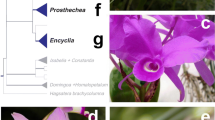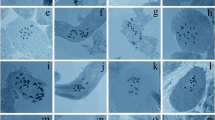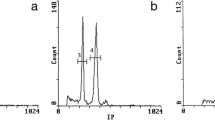Abstract
The Bromeliaceae family has been traditionally distributed in the subfamilies Bromelioideae, Tillandsioideae and Pitcairnioideae. However, phylogenetic studies have provided other classifications, highlighting the need for analyses in order to characterize the genome of different species from this family. In this sense, the present work aimed to determine nuclear 2C-value and base composition, characterize the chromosomes and establish the karyogram of Pitcairnia flammea. Flow cytometry yielded 2C = 1.44 pg, AT = 64.28 % and GC = 35.72 % for this species, indicating its relatively small genome size. Despite reduced length and morphological similarity of the chromosomes, P. flammea metaphases presented well-spread chromosomes, with well-defined primary constriction, without chromatin damage and cytoplasmic background. These aspects allowed morphometric chromosomal characterization and assembly of the first karyogram of a Bromeliaceae species. The karyogram displayed 2n = 50 chromosomes, of which all were submetacentric. Karyomorphological analysis revealed grouped pairs of cytogenetically identical chromosomes (2–3, 4–5, 6–9, 10–17, 18–19, 20–23 and 24–25), plus one isolated chromosome (1), not identical to any other. This result suggests an allopolyploid origin for the P. flammea genome. Thus, the present investigation contributed with karyotype data for taxonomic and evolutionary aspects of this group.

Similar content being viewed by others
References
Adams KL, Wendel JF (2005) Polyploidy and genome evolution in plants. Curr Opin Plant Biol 8:135–141. doi:10.1016/j.pbi.2005.01.001
Assis JGA, Ceita O, Cotias-de-oliveira ALP, Palmeira ACL, Guedes MLS (2004) Chromosome number for Bromeliaceae species occurring in Brazil. Cytologia 69:161–166. doi:10.1508/cytologia.69.161
Bennett MD, Leitch IJ (2011) Nuclear DNA amounts in angiosperms: targets, trends and tomorrow. Ann Bot Lond 107:467–590. doi:10.1093/aob/mcq258
Brown GK, Gilmartin AJ (1989) Chromosome numbers in Bromeliaceae. Am J Bot 76:657–665
Carvalho CR, Clarindo WR, Almeida PM (2007) Plant cytogenetics: still looking for the perfect mitotic chromosomes. Nucleus 50:453–462
Carvalho CR, Clarindo WR, Praça MM, Araújo FS, Carels N (2008) Genome size, base composition and karyotype of Jatropha curcas L., an important biofuel plant. Plant Sci 174:613–617. doi:10.1016/j.plantsci.2008.03.010
Ceita GO, Assis JGA, Guedes MLS, Cotias-de-Oliveira ALPC (2008) Cytogenetics of Brazilian species of Bromeliaceae. Bot J Linn Soc 158:189–193. doi:10.1111/j.1095-8339.2008.00776.x
Clarindo WR, Carvalho CR (2008) First Coffea arabica karyogram showing that this species is a true allotetraploid. Plant Syst Evol 274:237–241. doi:10.1007/s00606-008-0050-y
Clarindo WR, Carvalho CR, Alves BMG (2007) Mitotic evidence for the tetraploid nature of Glycine max provided by high quality karyograms. Plant Syst Evol 265:101–107. doi:10.1007/s00606-007-0522-5
Cotias-de-Oliveira ALP, Assis JGA, Bellintani MC, Andrade JCS, Guedes MLS (2000) Chromosome numbers in Bromeliaceae. Genet Mol Biol 23:173–177. doi:10.1590/S1415-47572000000100032
Cotias-de-Oliveira ALP, Assis JGA, Bellintani MC (2005) Chromosomal Evolution of Bromeliaceae. Cytologia 70:129–133
Doležel J, Bartoš J, Voglmayr H, Greilhuber J (2003) Nuclear DNA and genome size of trout and human. Cytometry 51:127–128. doi:10.I002/cyto.a.I003
Ebert I, Till W (1997) Nuclear genome size in Pitcairnioideae (Bromeliaceae) with emphasis on the genus Pitcairnia. Abstracts, Angiosperm Genome Size Discussion Meeting. p. 15. Royal Botanical Gardens, Kew. 11–12 Sept 1997
Favoreto FC, Carvalho CR, Lima ABP, Ferreira A, Clarindo WR (2012) Genome size and base composition of Bromeliaceae species assessed by flow cytometry. Plant Syst Evol 298:1185–1193. doi:10.1007/s00606-012-0620-x
Freitas DV, Carvalho CR, Filho FJN, Astolfi-filho S (2007) Karyotype with 210 chromosomes in guaraná (Paullinia cupana ‘Sorbilis’). J Plant Res 120:399–404. doi:10.1007/s10265-007-0073-4
Gitaí J, Horres R, Benko-Iseppon AM (2005) Chromosomal features and evolution of Bromeliaceae. Plant Syst Evol 253:65–80. doi:10.1007/s00606-005-0306-8
Givnish TJ, Millan KC, Berry PE, Stysma KJ (2007) Phylogeny, adaptive radiation, and historical biogeography of Bromeliaceae inferred from ndhF sequence data. Aliso 23:3–26
Givnish TJ, Barfuss MHJ, Benjamin EEV, Riina R, Schulte K, Horres R, Gonsiska PA, Jabaily RS, Crayn DM, Smith JAC, Winter K, Brown GK, Evans TM, Holst BK, Luther H, Till W, Zizka G, Berry PE, Sytsma KJ (2011) Phylogeny, adaptive radiation, and historical biogeography in Bromeliaceae: insights from an eight-locus plastid phylogeny. Am J Bot 98:872–895. doi:10.3732/ajb1000059
Louzada RB, Palma-Silva C, Corrêa AM, Kaltchuk-Santos E, Wanderley MGL (2010) Chromosome number of Orthophytum species (Bromeliaceae). Kew Bull 65:53–58. doi:10.1007/s12225-010-9175-6
Madlung A, Tyagi AP, Watson B, Jiang H, Kagochi T, Doerge RW, Martienssen R, Comai L (2005) Genomic changes in synthetic Arabidopsis polyploids. Plant J 41:221–230. doi:10.1111/j.1365-313X.2004.02297.x
Masterson J (1994) Stomatal size in fossil plants: evidence for polyploidy in majority of angiosperms. Science 264:421–423
Murashige T, Skoog F (1962) A revised medium for rapid growth and bioassays with tobacco tissue cultures. Physiol Plant 15:473–497
Palma-Silva C, Santos DG, Kaltchuk-Santos E, Bodanese-Zanettini MH (2004) Chromosome numbers, meiotic behavior and pollen viability of species of Vriesea and Aechmea genera (Bromeliaceae) native to Rio Grande do Sul, Brazil. Am J Bot 91:804–807. doi:10.3732/ajb.91.6.804
Praça- Fontes MM, Carvalho CR, Clarindo WR, Cruz CD (2011) Revisiting the DNA C-values of the genome size-standards used in plant flow cytometry to choose the ‘‘best primary standards’’. Plant Cell Rep 30:1183–1191. doi:10.1007/s00299-011-1026-x
Praça-Fontes MM, Carvalho CR, Clarindo WR (2011) C-value reassessment of plant standards: an image cytometry approach. Plant Cell Rep 30:2303–2312. doi:10.1007/s00299-011-1135-6
Ramírez-Morillo IM, Brown GK (2001) The origin of the low chromosome number in Cryptanthus (Bromeliaceae). Syst Bot 26:722–726. doi:10.1043/0363-6445-26.4.722
Sgorbati S, Labra M, Grugni E, Barcaccia G, Galasso G, Boni U, Mucciarelli M, Citterio S, Iramátegui AB, Gonzales LV, Scannerini AS (2004) Survey of genetic diversity and reproductive biology of Puya raimondii (Bromeliaceae), the endangered queen of the Andes. Plant Biol 6:222–230. doi:10.1055/s-2004-817802
Soltis DE, Soltis PS (1993) Molecular-data and the dynamic nature of polyploidy. Crc Cr Rev Plant Sci 12:243–273. doi:10.1080/07352689309701903
Versieux LM (2009) Sistemática, Filogenia e Morfologia de Alcantarea (Bromeliaceae). Tese (Doutor em Botânica). Instituto de Biociências. Universidade de São Paulo. doi:10.1111/j.1095-8339.2008.00895.x
Acknowledgments
The authors are grateful to Conselho Nacional de Desenvolvimento Científico e Tecnológico (CNPq, Brasília, DF, Brazil), Fundação de Amparo à Pesquisa do Espírito Santo (FAPES, Vitória, ES, Brazil), Fundação de Amparo à Pesquisa do Estado de Minas Gerais (FAPEMIG, Belo Horizonte, MG, Brazil), and Coordenação de Aperfeiçoamento de Pessoal de Nível Superior (CAPES, Brasília, DF, Brazil) for financial support.
Author information
Authors and Affiliations
Corresponding author
Rights and permissions
About this article
Cite this article
Nunes, A.C.P., Nogueira, E.U., Gontijo, A.B.P.L. et al. The first karyogram of a Bromeliaceae species: an allopolyploid genome. Plant Syst Evol 299, 1135–1140 (2013). https://doi.org/10.1007/s00606-013-0784-z
Received:
Accepted:
Published:
Issue Date:
DOI: https://doi.org/10.1007/s00606-013-0784-z




